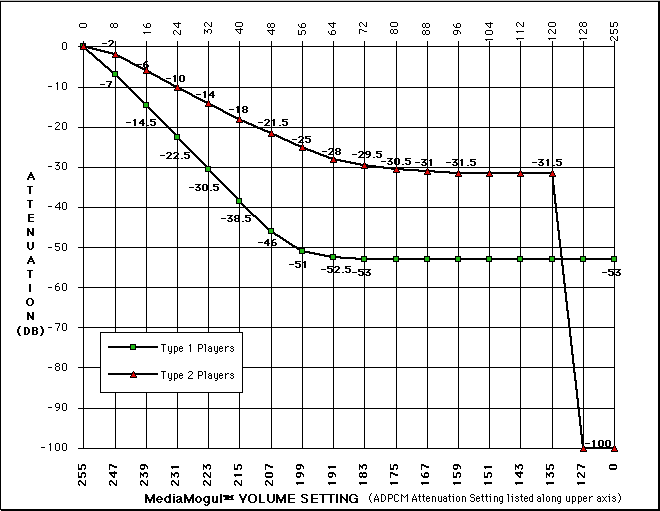Home Page · Up 1 Level · Site Map · Send Us Mail · ICDIA Main
| Player Types and ADPCM Volume |
Recently, Philips discovered an anomaly in how various models of CD-i players
respond to volume level adjustment. The anomaly only effects ADPCM volume, and
effects CD-i applications made under MediaMogul, ShowMaster and "C" programming
tools.
Since the first CD-i players were available, Philips has continually sought to further
reduce production costs and increase reliability. Their efforts were concentrated at
reducing circuit complexity as newer player models were designed. Philips tracks these
complexity reductions via levels of "monolithicness" of the main circuit board. For
example; The first player models, like the 910, were termed "maxiMMC". The first
U.S. 220 model (220/17) was "miniMMC", the second generation 220/37 was "Mono I",
the third generation 220/57 was "Mono II" and so on. The 220/97--the newest 220--is
"Mono IV". The professional and portable CD-i players also carry similar monolithic
designations. A complete chart of model versus board level follows later in this article.
Over the many board changes, the ADPCM attenuator unit has inadvertently been
altered and thus does not respond to application volume commands in the same
manner across the many Philips player models.
| ADPCM Attenuator Background: |
The CD-i player attenuator unit design is regulated by the Green Book specification for
CD-i as follows:
There are FOUR separately controllable attenuators in the unit:
- R-R - manipulates signal passing from unit RIGHT input to unit RIGHT output
- L-L - manipulates signal passing from unit LEFT input to unit LEFT output (
- R-L - manipulates how much signal passes from unit RIGHT input to unit LEFT output
- L-R - manipulates how much signal passes from unit LEFT input to unit RIGHT output
Each attenuator is adjustable in 1 dB increments from NO attenuation (0 dB
attenuation) up to MAXIMUM attenuation (128 dB attenuation). Thus, there are 128
discrete settings for each of the four attenuators.
Note: The R-L and L-R attenuators in most applications are set to maximum
attenuation (128 dB) so that no left/right signal mixing occurs. MediaMogul does not
permit R-L or L-R attenuator adjustment. MediaMogul permits R-R and L-L adjustment
together through its VOLUME command.
The anomaly is manifested as a departure from the 1 dB per increment behavior described
above. None of the players exhibit linear (1 increment yields 1 dB change) attenuator
response over their entire range, and some of the players do not follow the
1dB/increment spec over any of their range.
The attenuator anomaly divides the players among "Mono" versions. Mono III and
Mono IV machines deviate the most, while Mono II and previous versions are closer to
the spec. For the Groups below, assume if no /xx number is specified that it applies to
all machines of that model. The list below is only for U.S. players, and is current as of
this document.
| Group 1 Players (maxiMMC, miniMMC, Mono I, Mono II): |
|---|
180, 601, 602, 604, 605, 605T
200/17, 200/37, 205/17, 210/17, 210/37, 220/37, 220/57, 350, 360, 910, Memorex 2200 |
|
Group 2 Players (Mono III, Mono IV): |
|---|
|
200/57, 210/57, 220/77, 220/97, 370, 380/17, 450, 470, 550, 615, 740, Goldstar GDI-1000 |
| Player Vs. Attenuator Response: |
Group 1 players have the following response:
- For each increment change in attenuation (a setting of 255 -> 254 in Mogul), there will
be a 1dB change until you reach 53 dB attenuation (a setting of 185 in Mogul).
- Any attenuation settings greater than 53 dB yield NO further attenuation--i.e. it bottoms
out at -53 dB.
- A setting of 128 dB attenuation will not fully attenuate or mute the signal.
Group 2 players have the following response:
- For each increment change in attenuation (i.e. 255 -> 254 in Mogul), there will be a 0.5
dB change until you reach 28 dB attenuation (Mogul setting of 191).
- Attenuation bottoms out at 31.5 dB until an attenuator setting of 126 (129 in Mogul) is
reached.
- At attenuator settings of 127 and 128 (128/127 in Mogul) the attenuation
jumps to 100 dB (essentially muted).
Graphically, player response looks like this:

Both Groups have irregular response, though Group 1 players are not available for sale
any longer. This leaves the highly aberrant Group 2 players.
In light of the attenuator response, we recommend that developers simply produce
ADPCM assets carefully--monitoring levels closely between all ADPCM clips in the
title, and also taking care to match levels to the MPEG assets. The second part of the
recommendation is to leave the attenuator settings at NO attenuation (255 in Mogul).
This is the ONLY setting that produces the same attenuation (albeit NO attenuation) across ALL player groups.
Home Page · Up 1 Level · Site Map · Send Us Mail · ICDIA Main
